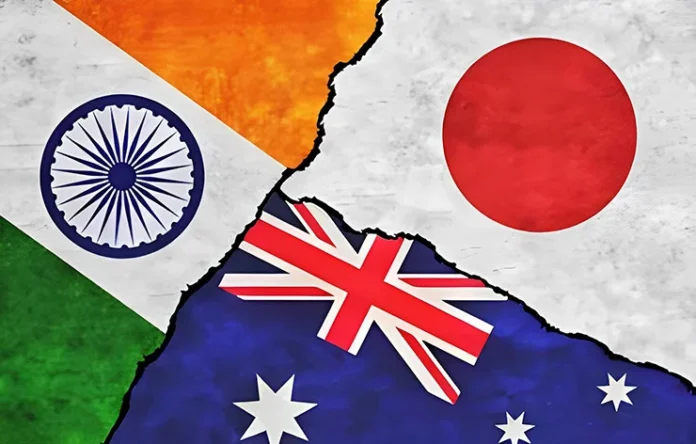A trilateral arrangement between nations was an idea promoted in the 1970s, that the countries of Western Europe, the United States, and Japan shared common interests as democracies and industrialised nations. The idea inspired the formation of a Trilateral Commission to promote cooperation between the three regions to achieve common goals related to security, politics and economics.
In the context of Asia, the trilateral cooperation in Indo-Pacific region is in regard to Australia, Japan and India (AJI), a strategic partnership that provides for opportunities as well as tackling challenges in the region.
The dynamics of trilateral arrangement depends on convergences and workable mechanisms to cooperate in the Indo-Pacific region. The trilateral AJI is potentially the strongest example of a multilateral coalition in the Indo-Pacific, today.
However, AJI is incomplete without according due primacy to ASEAN’s centrality. The bilateral strategic partnerships between/within AJI holds the key to a resurgent Asia and devising ways to deal with and manage China. It is necessary to develop diplomatic structures and military areas of common engagement, independent of United States in the long run.
Taking the United States out of strategic equation may at times be necessary and beneficial to reflect upon ways for Asian powers – AJI to facilitate, consult and collaborate on a wider spectrum of strategic issues of security and connectivity in the Indo-Pacific region.
Semantics of Indo-Pacific region
As Amitav Acharya has noted, strategists in international relations have driven the Indo-Pacific construct. Generally speaking, Indo-Pacific is a combination of Indian Ocean and Pacific Ocean. Defining and articulating Indo-Pacific region has been different for the partners of trilateral co-operation (AJI).
Australia’s geographical definition of “Indo-Pacific” enveloped an area “extending from India through Southeast Asia to Northeast Asia, including the sea lines of communication (Defence White Paper, 2013)”. This definition evolved to identify the region “ranging from the eastern Indian Ocean to the Pacific Ocean connected by Southeast Asia, including India, North Asia and the United States (Foreign Policy Paper, 2017)”.
Trilateral cooperation in Indo-Pacific region is in regard to Australia, Japan and India (AJI), a strategic partnership that provides for opportunities as well as tackling challenges in the region
The notion of Indo-Pacific can be found in late Prime Minister Abe’s speech, before the Indian Parliament in August 2007. He preferred the geographical term of ‘broader Asia’ to Indo-Pacific. Broader Asia took shape at the confluence of two seas. It was interpreted as an integration of East Asia and South Asia, in which Japan and India should work together as key players.
Japan’s Free and Open Indo-Pacific (FOIP) strategy in 2016 called for a conjoining of continents (Asia and Africa) and oceans (the Pacific and Indian) with the Association of South East Asian Nations (ASEAN) as the facilitating link.
Within this vast region, Japan pledged to foster democracy, capacity building, the rule of law, a market economy and freedom from force or coercion.
In June 2018, Prime Minister Modi presented India’s vision of “Indo-Pacific” in his keynote address at the Shangri-La Dialogue. He described “Indo-Pacific” as a natural region, and concretely as a region “from the shores of Africa to that of the Americas”. In particular, he mentioned the Pacific and most of India’s partners — ASEAN, Japan, Republic of Korea, China, the Americas, territories in the Indian Ocean region, Australia, New Zealand, Pacific Island nations, Russia and Africa. India does not see the Indo-Pacific Region as a strategy or as a club of limited members. It neither is a grouping that seeks to dominate and by no means considered as directed against any country.
Elements of India’s Indo-Pacific strategy
There were seven elements of Indo-Pacific strategy articulated by PM Narendra Modi at the Shangri-La Dialogue in 2018. First, the Indo-Pacific strategy stands for a free, open and inclusive region in a common pursuit of progress and prosperity.
Second, ASEAN is central to the strategy of Indo-Pacific region. Third, a common rules-based order that respect sovereignty and territorial integrity of nations must be upheld. Fourth, the key players in the region ought to have equal access as a right under international law to the use of common spaces on sea and in the air that would require freedom of navigation, unimpeded commerce and peaceful settlement of disputes in accordance with international law.

Fifth, India stands for an open and stable international trade regime that support rule-based, open, balanced and stable trade environment in the Indo-Pacific Region. Sixth, India believes that connectivity initiatives of trade and infrastructure must be based on respect for sovereignty and territorial integrity, consultation, good governance, transparency, viability and sustainability.
Seventh, India advocates for a vision of Asia that cooperates and forges partnerships based on shared values and interests. The Indo-Pacific Oceans Initiative (IPOI) in 2019 is a collaborative approach to address shared challenges and strengthens maritime boundaries and partnerships, focusing on free trade and sustainable resource usage. It encompasses seven thematic areas, including resource development, resilient infrastructure, security, and marine environment.
India-Japan’s Special and Strategic Global Partnership
The goal of India-Japan cooperation is to stabilise the Indo-Pacific region by restraining Chinese behaviour. Japan’s Free and Open Indo-Pacific (FOIP) strategy and India’s Indo-Pacific Oceans Initiative (IPOI) have provided the framework for the two countries to deepen their strategic partnership and cooperation in the region.
Japan’s Free and Open Indo-Pacific strategy in 2016 called for a conjoining of Asia and Africa and the Pacific and Indian oceans with the Association of South East Asian Nations as the facilitating link
India-Australia’s Comprehensive and Strategic Partnership
The common objective for India and Australia in the Indo-Pacific can be defined as “maintaining a stable and secure norms in an interconnected Indo-Pacific while preserving an order based on sovereignty and the rule of law”. This will inevitably require balancing China, to ensure that its preponderant power does not enable it to impose its will on the region without consequences. India and Australia have a shared interest in promoting maritime security and safety, deepen navy-to-navy cooperation and strengthen maritime domain awareness in the Indo-Pacific region through enhanced exchange of information
Japan-Australia Special Strategic Partnership
Australia and Japan are working together to maintain the stability, resilience and prosperity of the Indo-Pacific region. Both nations agreed to a strategy for cooperation in the Pacific in 2016. The Strategy outlines four areas for cooperation: effective governance, economic growth and sustainable development, security and defence cooperation, and diplomatic initiatives
AJI – a SWOT Analysis
According to scholars, Australia-India-Japan (AJI) Trilateral must overcome connect contradictions. There is lack of strategic convergence on critical sub-regions of the Indo-Pacific (for example Pacific Islands Countries), which has hindered a strategic bonding among the three countries.
AJI potentialities and capacities are yet to be harnessed in Asia-Africa Growth Corridor (AAGC) scheme of projects. AJI are important dialogue partners of ASEAN and can make strategic interventions in light of belligerent China’s assertions in South China Sea. Bilateral mechanisms and structures of consultations can bolster AJI forward, keeping in mind ASEAN concerns and therein promoting peace and prosperity in the Indo-Pacific region.
-The writer is Assistant Professor, School of Law, Presidency University, Bengaluru. View expressed are personal and do not reflect that of Raksha Anirveda
–The writer is Assistant Professor, ICFAI School of Liberal Arts, ICFAI University, Jaipur. The views expressed are of the writer and do not necessarily reflect the views of Raksha Anirveda






